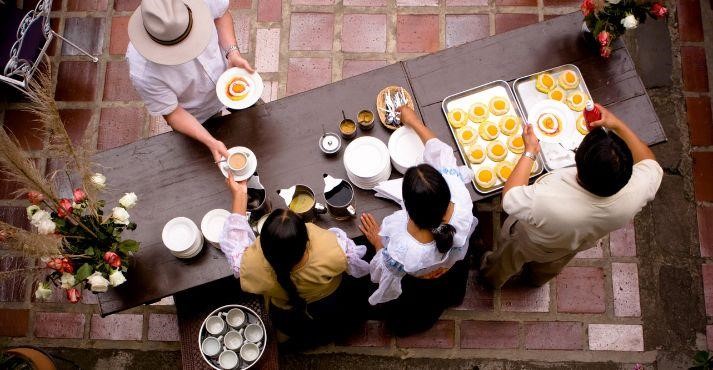F&B, short for Food and Beverage, is the hospitality industry’s backbone, including everything from dining experiences to catering services. Understanding F&B is crucial for businesses aiming to deliver exceptional customer satisfaction, as it directly impacts revenue and reputation.
For consumers, grasping F&B ensures informed choices when dining out or organizing events. Moreover, individuals aspiring to join the food industry benefit from a comprehensive understanding of F&B, covering the way for rewarding careers in restaurants, hotels, and catering companies.
Knowing what F & B is is essential for success in both business and personal endeavors within the food sector.
What is F&B?

F&B, short for Food and Beverage, involves the variety of food and drink options in eateries like restaurants and cafes. In Singapore, where food is celebrated, F&B is at the heart of the dining scene.
From bustling hawker centers serving local delights to upscale restaurants offering fine dining experiences, F&B establishments cater to varied tastes and preferences.
Beyond merely providing sustenance, F&B contributes significantly to Singapore’s tourism industry and creates job opportunities for many.
Understanding F&B is essential for fully appreciating Singapore’s rich culinary heritage and exploring its vibrant food culture. It allows individuals to understand the city’s bustling dining arena and enjoy its unique flavors and experiences.
Overview of the F&B Industry in Singapore

Singapore’s F&B scene is a bustling hub of culinary delights, offering something for every palate. With a market value surpassing SGD 13.6 billion annually, it’s clear that dining out is a favorite pastime.
The diversity of options is remarkable, from humble hawker stalls serving popular local dishes to upscale eateries offering world-class cuisine.
Various factors fuel the industry’s growth, including a rising number of tourists, a growing affluent population, and the increasing popularity of food delivery services; this growth has led to the rise of a wide range of establishments, from cozy cafes to bustling food courts, all contributing to the vibrant food culture of the city-state.
Singapore’s government actively supports culinary innovation and entrepreneurship, promoting an environment conducive to culinary excellence.
As a result, Singapore has become a magnet for both local and international chefs and food businesses, further enhancing its culinary industry and cementing its status as a global food destination.
Components of F&B
Let’s learn more about the different kinds of food and beverages that make Singapore’s dining scene so exciting.
Food
Singapore’s F&B scene offers a tempting array of culinary delights, reflecting the nation’s multicultural fabric. From iconic local dishes like Hainanese chicken rice and laksa to international cuisines such as Japanese sushi and Italian pasta, there’s something to satisfy every craving.
With their bustling atmosphere and affordable fare, Hawker centers are beloved destinations for sampling authentic Singaporean flavors. Additionally, fine dining establishments showcase the creativity and craftsmanship of chefs and offer fine culinary experiences.
Beverage
In addition to diverse cuisines, Singapore’s F&B landscape claims a rich variety of beverages to complement meals or enjoy on their own. Traditional drinks like Teh Tarik (pulled tea) and Kopi (local coffee) are beloved staples, while specialty coffees brewed with precision and care have gained popularity among coffee lovers.
Singapore’s cocktail scene is booming for those seeking a refreshing blend. Noveloctions inspired by local flavors and global trends are available, whether a classic Singapore Sling or a creative craft cocktail; the city’s bars and lounges offer an attractive selection of drinks to suit every taste.
Types of F&B Services Operations
Let’s explore the various types of F&B service operations and how they make dining experiences unique.
1. Commercial
Commercial F&B operations are all about making tasty food and drinks while making a profit. Examples include restaurants, cafes, bars, food trucks, and catering services.
They focus on offering delicious meals and drinks to customers in exchange for money. Whether it’s a cozy café, a bustling restaurant, or a food truck serving treats on the go, commercial F&B operations work hard to create enjoyable dining experiences that keep customers coming back for more.
2. Non-commercial
Non-commercial F&B operations are different—they’re more about providing food and drinks for service rather than profit. These places include institutional dining, like in hospitals or schools, where the main goal is to feed people well.
Healthcare facilities ensure patients get nutritious meals, while schools serve lunches to students. Military installations also have non-commercial F&B operations to keep soldiers fueled up. In these places, the focus is on serving good food to fulfill needs rather than making money.
Importance of F&B in Singapore’s Hospitality Sector

In Singapore’s hospitality world, where hotels, restaurants, cafes, and bars are everywhere, Food and Beverage (F&B) plays a huge role. Picture this: when you stay at a hotel or dine out, you want a comfy bed and tasty food and drinks, right? Well, that’s where F&B comes in!
Here’s something cool: tourists spend lots of money on food and drinks in Singapore—about 30% of their total expenses! This helps the economy grow and brings in more visitors. Plus, F&B spots support local businesses and preserve our culture by serving traditional dishes.
F&B Operations and Management in Singapore

Running a food and beverage (F&B) business in Singapore involves several essential tasks to ensure everything runs smoothly. Here’s an overview to help you understand:
Menu Planning:
- Menu planning is like creating a list of dishes and drinks that a restaurant or cafe will offer to customers.
- It involves choosing recipes, pricing items, and ensuring various options for different tastes.
Food Sourcing:
- Food sourcing is about finding the best ingredients for cooking.
- It includes buying fresh produce from suppliers, checking for quality, and ensuring everything is safe to eat.
Kitchen Operations:
- Kitchen operations are all the activities behind the scenes to prepare and cook food.
- Chefs and kitchen staff work together to follow recipes, cook food properly, and keep everything clean and organized.
Customer Service:
- Customer service is how staff treat and interact with customers.
- Being friendly, helpful, and attentive is essential to ensure customers have a good experience.
Regulations and Standards:
- In Singapore, there are rules and regulations that F&B businesses must follow to ensure food safety and hygiene.
- These include getting the proper licenses and permits, following food handling and storage guidelines, and keeping the premises clean.
Hygiene Standards:
- Hygiene standards are essential to ensure the food served is safe.
- F&B businesses in Singapore must meet strict hygiene standards set by authorities to prevent foodborne illnesses and keep customers healthy.
Sustainability and Ethical Practices

The F&B industry is changing, and more and more people are choosing to do things that are friendly to our planet.
Imagine a restaurant that uses ingredients that are grown in ways that don’t harm the earth. That’s what responsible sourcing is all about. It’s like ensuring that the things on your plate are also good for the planet. And that’s not all – many restaurants are also trying to use less plastic and be more eco-friendly.
Ethical practices are also a big deal. This means treating everyone fairly, from the farmers who grow the food to the workers in the restaurants. It’s like making sure that everyone is happy and treated well.
Why does all of this matter? Well, there are many people who care about the environment and want to support businesses that do too. When you choose to eat at sustainable and ethical places, you’re making a difference.
Digitalization and Technology

Some apps allow you to order food online and have it delivered right to your door. It’s like having a restaurant come to you! And have you ever seen those cool machines that recommend what to order based on what you like? That’s AI – artificial intelligence – at work. It’s like having a super-smart helper guide you through the menu.
But technology isn’t just for at-home dining. When you go out to eat, you might find interactive menus on tablets that let you see pictures of the dishes and even customize your order. It’s like choosing exactly what you want with just a tap.
And guess what? All these technological breakthroughs often make their debut at food service trade shows. These events are like big parties for people in the food business. They show off the latest technologies, machines, and ideas that are changing how we serve, eat, and drink.
Global Influence on Local Palates

Imagine tasting a pizza topped with flavors from a faraway land. That’s what global influence on local palates means. Sometimes, foods from different countries become so popular that they mix with our own traditional dishes. It’s like having a little taste adventure right on our plates.
Think about your favorite meal. Now, imagine if someone added a twist from another country to make it even more exciting. That’s what’s happening in the F&B world. Chefs are taking familiar foods and giving them a global makeover. It’s like combining the best of both worlds in a single bite!
So, how does this happen? Well, just like people bring back souvenirs from their trips, chefs bring back new cooking ideas. And sometimes, these exciting flavors show up at food service trade shows, where everyone can get a taste of the delicious fusion!
Frequently Asked Questions (FAQs)
What is QSR (Quick Service Restaurants)?
QSRs are fast-food restaurants where food is prepared, served, and consumed quickly. Examples include McDonald’s and Subway, focusing on convenience as the main factor.
What is FSR (Full Service Restaurants)?
FSRs are dining establishments where customers are seated and served by waitstaff. These restaurants offer a wide food and beverage menu and emphasize customer satisfaction and experience.
Is F&B part of hospitality?
Yes, F&B (Food and Beverage) is significant to hospitality. It includes providing food and drink services in various settings, such as hotels, restaurants, and bars, ensuring guests have enjoyable dining experiences during their stay or visit.
Conclusion
Food brings people together from all over the world. It’s a way to share stories, traditions, and cultures. When we sit down to enjoy a meal, we’re connecting with each other in a special way.
And don’t forget about how F&B boosts economies too! Restaurants, cafes, food trucks – they all create jobs and opportunities. So, the next time you munch on something delicious, remember that you’re also part of this big, flavorful world that’s always changing and evolving.
Whether it’s trying out innovative dishes, exploring new trends, or simply enjoying your favorite meal, the F&B universe is full of surprises waiting to be savored.













